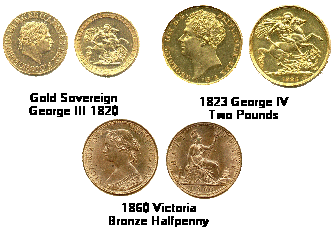The money system used in Victorian England had existed for several hundred years. It wasn't until 1971 that the currency was divided into 100 smaller units and decimalized being divided in precise divisions of halves, quarters, fifths, tenths, twentieths, twenty-fifths, and fiftieths. Until that time, however, the British pound sterling consisted of 240 parts (halves, thirds, quarters, fifths, sixths, eighths, tenths, twelfths, fifteenths, sixteenths, twentieths, twenty-fourths, thirtieths, fortieths, forty-eightieths, sixtieths, eightieths, and one-hundred and twentieths.
The symbols used to express Victorian money was the following:
| Pound | £ |
| Shilling | s |
| Penny | d |
Written in its descending order is simple: £2-4s-6d. If the amount was below a pound it might be written as 4/6, 4s-6d or 10/ (ten shillings). The amount 4/6 would be pronounced "four and six". A shilling was also called a "bob" but only for whole shillings.
Another monetary expression is a "guinea" which was £1-1s-od or £1.05. Tradesmen were paid in pounds, but gentlemen such as an artist, in guineas. In the legal profession, a barrister was paid in guineas, kept the pounds and gave his male clerks (a "Bob Crachit") the shillings. A guinea could also be divided into many different amounts and a third of a guinea was exactly seven shillings.
 In 1817, coins were minted in gold and silver. A gold coin was worth £1 and was also called a "sovereign; the half sovereign was ten shillings and also gold. The "crown" was a silver coin worth 5s, a half-crown 2/6 or 1/8 of a pound. The shilling was also silver as were sixpence, threepence, and four pence (also known as a "groat". Half-groats and silver pennies were not in circulation during the Victorian era, however, they were minted for a tradition called Maundy Money whereby the Monarch would give the poor people (the number of which is defined by the same number of the monarch's years) in the parish a groat, threepence, half groat and a penny.
In 1817, coins were minted in gold and silver. A gold coin was worth £1 and was also called a "sovereign; the half sovereign was ten shillings and also gold. The "crown" was a silver coin worth 5s, a half-crown 2/6 or 1/8 of a pound. The shilling was also silver as were sixpence, threepence, and four pence (also known as a "groat". Half-groats and silver pennies were not in circulation during the Victorian era, however, they were minted for a tradition called Maundy Money whereby the Monarch would give the poor people (the number of which is defined by the same number of the monarch's years) in the parish a groat, threepence, half groat and a penny.
Smaller valued coins originally made of copper were changed to bronze after 1860. With the penny, came the halfpenny, sometimes referred to as ha'penny) and the farthing, a quarter of a penny.
One can well imagine that purchasing goods with currency broken down into so many "odd" values could prove a bit cumbersome and one needed to be very good at math, especially if you didn't want to be cheated.
| One pound (£) | 20 shillings (s) |
| One shilling | 12 pence (d) |
| One penny | Two half pennies and four farthings |
| One guinea | 21 shillings |
| Gold sovereign | One pound |
| Half Crown | 2s 6d |
| Florin | Two shillings |
| Silver Sixpence | 6d |
| Threepenny | 3d |
Moving towards a system of decimalization, the Victorians did produce a new two shilling coin in 1849 called a "Florin". This coin was minted until 1968 and then redesigned to form the new ten pence coin. The half-crown was also taken out of circulation in 1970. Guineas also disappeared early in the period not being minted after 1813.
Banknotes (paper money)
Paper money was first issued by the Bank of London in the 1690s, but was not accepted for use by many and being hand-signed did not encourage confidence in this form of currency. As the result of an economic crisis in 1797, the Bank stopped making payments in coins for more than £1 thus increase in quantity and circulation of banknotes. They lasted until 1828 when the Bank began issuing £5 notes. In 1853 the bank begin to print the notes with signatures eliminating the need of "hand-written" ones.
The change to decimalized coinage was made on February 15, 1971. The pound was then divided into 100 pennies worth 2.4 pence. Ten and five pence coins were phased in from 1968 and the fifty pence in October 1969 which replaced the ten shilling note.
Back to Intro/Index or Site Map
| | Family Gallery | Servants Parlour | Tour Home | Typical Day | Etiquette | Shopping Trip | |
| | Victorian Christmas | Victorian England Fun and Games | Ashton Library | Victorian Wedding | |
| | Victorian England Overview | Guest Registry | Honorary Victorian | Tours | |
| | Awards Received | Bibliography | |
| | 1876 Victorian England Home | |
Credits below copyright information |
| Contact
webmaster |
| Copyright
1999-2017 All Rights Reserved - B. Malheiro May not be reproduced in any way without express written permission of webmaster. |
Credits:
Background and buttons are the creation of webmaster, B. Malheiro. These images have been watermarked and are not for use on another site. Site authored by webmaster.
1. Clapham, Economic History of Modern Britain "Free Trade and Steel 1850 - 1886".
2. Best, Mid-Victorian Britain 1851-1875.